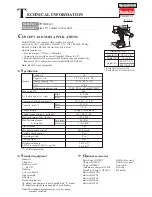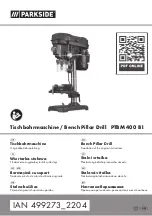
GB
- 8 -
4. Technical data
Voltage supply ........................................18 V d.c.
Idling speed: ............................0-350/0-1250 rpm
Torque settings: ....................................... 18+1+1
Forward and reverse rotation ..........................yes
Chuck clamping width ....................... max. 13 mm
Battery charger output voltage: ............. 21 V d. c.
Battery charger output current: ....................... 3 A
Mains voltage for charger: ..200-250 V~ 50-60 Hz
Battery type: .......................................Lithium-ion
Number of battery cells: .................................... 5
Battery capacitance: ................................. 1.5 Ah
Weight.........................................................1.6 kg
Max. screw diameter: .................................. 6 mm
The maximum screw diameter indicates the ma-
ximum diameter of the screw that can be screwed
into wood. The screw diameter can vary depen-
ding on the type of wood.
Danger!
Sound and vibration
Sound and vibration values were measured in
accordance with EN 62841.
L
pA
sound pressure level ................... 86.72 dB(A)
K
pA
uncertainty .............................................3 dB
L
WA
sound power level ....................... 97.72 dB(A)
K
WA
uncertainty .............................................3 dB
Wear ear-mu
ff
s.
The impact of noise can cause damage to hea-
ring.
Total vibration values (vector sum of three direc-
tions) determined in accordance with EN 62841.
Drilling in metal
Vibration emission value a
h,D
≤
2.5 m/s
2
K uncertainty = 1.5 m/s
2
Impact drilling in concrete
Vibration emission value a
h,ID
= 15.233 m/s
2
Uncertainty K = 1.5 m/s
2
The stated vibration emission levels and stated
noise emission values were measured in ac-
cordance with a set of standardized criteria and
can be used to compare one power tool with
another.
The stated vibration emission levels and stated
noise emission values can also be used to make
an initial assessment of exposure.
Warning:
The vibration and noise emission levels may vary
from the level speci
fi
ed during actual use, depen-
ding on the way in which the power tool is used,
especially the type of workpiece it is used for.
Keep the noise emissions and vibrations to a
minimum.
•
Only use appliances which are in perfect wor-
king order.
•
Service and clean the appliance regularly.
•
Adapt your working style to suit the appliance.
•
Do not overload the appliance.
•
Have the appliance serviced whenever ne-
cessary.
•
Switch the appliance off when it is not in use.
•
Wear protective gloves.
Caution!
Residual risks
Even if you use this electric power tool in
accordance with instructions, certain resi-
dual risks cannot be rules out. The following
hazards may arise in connection with the
equipment’s construction and layout:
1. Lung damage if no suitable protective dust
mask is used.
2. Damage to hearing if no suitable ear protec-
tion is used.
3. Health damage caused by hand-arm vib-
rations if the equipment is used over a pro-
longed period or is not properly guided and
maintained.
Limit the operating time.
All stages of the operating cycle must be conside-
red (for example, times in which the electric tools
are switched o
ff
and times in which the tool is
switched on but operates without load).
Anl_TE_CD_18_44_Li_i_Kit_SPK7.indb 8
Anl_TE_CD_18_44_Li_i_Kit_SPK7.indb 8
09.06.2020 12:55:45
09.06.2020 12:55:45




































